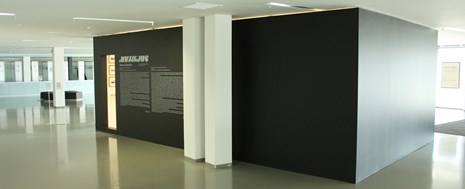Dainius Liškevičius

Dainius Liškevičius. Museum
The theme is the artist, the objective is the liberation of art.'
Dan Graham
(presentation to an open meeting of the Art Workers' Coalition, 1969)
'Museum' is a new artistic project from Dainius Liškevičius, where he opens up the concepts of creativity and creation for wider discussion. A democratic discussion, in counterbalance to dictatorship and conformism, appears as one of the key conditions for (creative) freedom.
In proactive imitation of the principles of museum operation and the status conferred by the institution, and by drawing parallels between two historic Lithuanian personalities (who embody forms of resistance to the Soviet occupation and political protest) and the artist's own personal life and career, he establishes the idea of protest as an act of creation.
When considering the history of Soviet-period resistance and artistic life, Liškevičius suggests that we expand the discourse of Soviet Lithuanian art history by the inclusion of political protest as a practice of art creation, and he supports the proposition with additional arguments that developments in Western art were almost completely unknown in Lithuania. The individual's political protest in this project is interpreted as the most radical means of expression, in opposition to ideological dictatorship and in discussion with Silent Modernism as a moderate stand. Antanas Kraujelis, Romas Kalanta and Bronius Maigis are undoubtedly the most dramatic and the most prominent examples of political protest in the Soviet 1960s, 1970s and 1980s. They left a significant mark on the history of civil resistance in Lithuania to the occupation. Antanas Kraujelis was a member of the postwar resistance, the last partisan, who shot himself on 17 March 1965, when his hiding place was surrounded by the KGB. His struggle is compared to the underground art movement. Romas Kalanta was a dissident who, in protest against the occupation of Lithuania, set fire to himself on 14 May 1972 in the garden of the Kaunas Musical Theatre. His death by self-immolation is compared with performance art. Bronius Maigis, on 15 June 1985, the anniversary of the first day of the mass destruction of the Lithuanian nation, performed a politically motivated act of vandalism against Rembrandt's masterpiece 'Danaë' at the Hermitage Museum. His act of vandalism in the Hermitage is identified with the equally controversial art destruction movement.
The story 'Museum' is a hyper-textual first-person narrative by Dainius Liškevičius, threading together, by logical, conceptual and formal links, Soviet-period forms of political protest presented at the exhibition, the historical personalities representing these forms, and cultural artefacts, with bits and pieces from the artist's career and his art.
Although the project 'Museum' works as an autonomous exhibition, the National Gallery of Art, the location selected for it, is marked by some exceptional facts related to the function and the history of the building. Until 1990, it housed the Museum of the Revolution; now it is home to an institution showing 20th-century Lithuanian art.
By appealing to democratic principles of constructive coexistence, the author seeks to generate a discussion which might give an impetus to the opening up of the concept of creation.
Dainius Liškevičius (b. 1970) is one of the most active artists of the 'breaking off generation', who in the 1990s made a significant contribution to the reinvention of artistic expression in Lithuania. His installations and performances are included in most recent histories of Lithuanian art.
Curator: Giedrius Gulbinas


